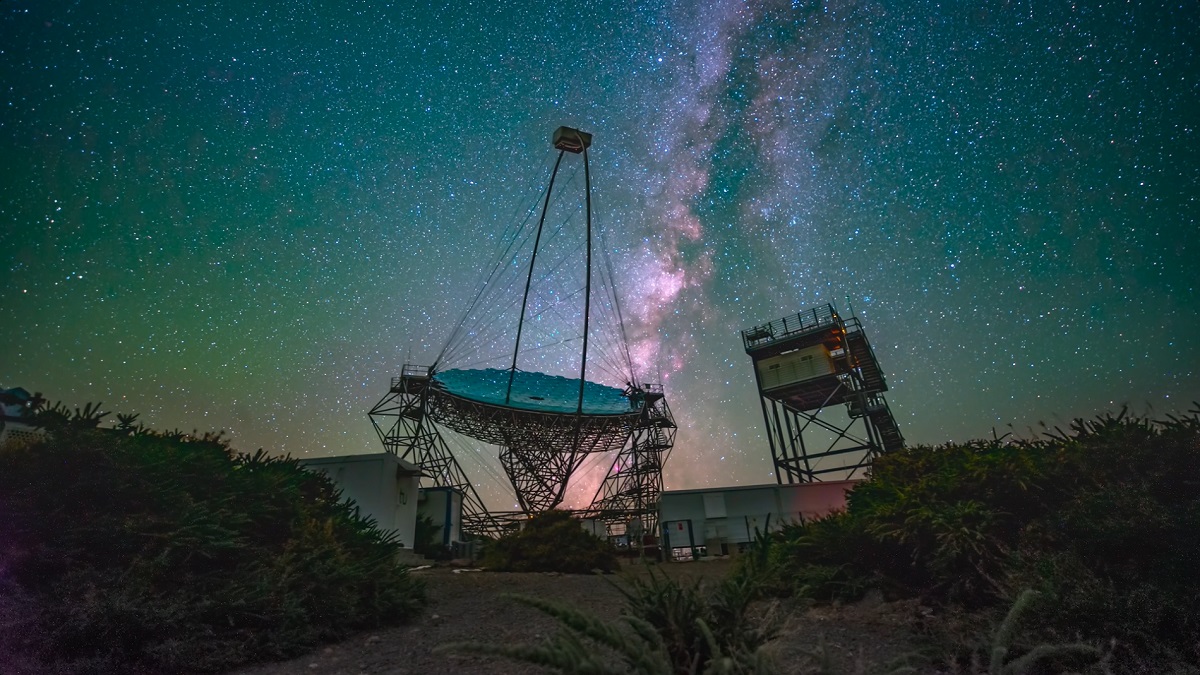The Large-Sized Telescope Collaboration discovers the most distant active galactic nucleus at very high energies
- The LST-1 telescope, still under commissioning, has made its first discovery from the Cherenkov Telescope Array Observatory in La Palma
- The object discovered is the tenth known quasar at very high energies and is located about 8 billion light-years away
- The IEEC participates in this scientific collaboration with researchers at the Institute of Cosmos Sciences (ICCUB) and the Institute of Space Sciences (ICE-CSIC)

Caption: LST-1 Telescope in La Palma, Spain.
Credits: CTAO gGmbH.
The Large-Sized Telescope (LST) Collaboration announced last month the detection of the most distant active galactic nucleus (AGN) ever detected by a very high energy gamma-ray telescope. The detected source, called OP 313, had previously been observed at low energies. The LST-1 telescope detected it above 100 gigaelectronvolts (GeV, an energy level a billion times higher than the visible light that humans can perceive), making this its first scientific discovery.
The Large-Sized Telescope (LST) is one of three types of telescope that will be built to cover the full energy range of the Cherenkov Telescope Array Observatory (CTAO), the first open ground-based gamma-ray observatory and the world’s largest and most sensitive instrument for the exploration of the high-energy Universe. Four LSTs will be arranged in La Palma, Spain. The LST-1 is the prototype of the LST, currently under commissioning, but already performing well, as this finding shows. Each LST is a giant 23 metre diameter telescope with a mirror area of about 400 square metres and a fine pixelized camera made of 1855 light sensors capable of detecting individual photons with high efficiency.
The Institute of Space Studies of Catalonia (IEEC — Institut d’Estudis Espacials de Catalunya) has several researchers participating in the LST Collaboration. This is made up of over 400 scientists and engineers from 67 different institutions across twelve countries. IEEC researchers are divided between the Institute of Cosmos Sciences of the University of Barcelona (ICCUB) and the Institute of Space Sciences (ICE-CSIC).
The object detected by LST-1 is what is known as a Flat Spectrum Radio Quasar or FSRQ, a type of AGN. These are very luminous objects found in the centres of some galaxies, where a supermassive black hole devours material from its surroundings, creating powerful accretion disks and jets of light and relativistic particles.
Only nine quasars are known at very high energies, and OP 313 is now the tenth. In general, quasars are more difficult to detect at very high energies than other types of AGN. This is not only because the brightness of their accretion disk weakens the emission of gamma rays, but because they are further away. In this case, OP 313 is located about 8 billion light years away, making it the most distant AGN and the second most distant source ever detected at very high energies.
The more distant the source, the more difficult it is to observe at very high energies due to the so-called Extragalactic Background Light or EBL. The EBL is the collective light emitted by all objects outside the Milky Way that expands across multiple wavelengths, from visible, infrared and ultraviolet. The EBL interacts with very high-energy gamma rays, attenuating their flux and, thus, making their observation challenging. The characteristics of the LST-1, with an optimized sensitivity for the CTAO’s low energy range, between 20 and 150 GeV, where gamma rays are less affected by the EBL, enabled the LST Collaboration to extend the study of this source to tens of GeV for the first time.
The LST Collaboration will continue to observe this source with the LST-1 to expand the dataset and, thus, obtain a more precise analysis that allows scientists to improve their understanding of the EBL, study the magnetic fields within this type of source or delve into fundamental intergalactic physics.
Press release prepared in collaboration with the Institute of Cosmos Sciences.
More information
Aquest descobriment es va anunciar en un Astronomer’s Telegram, el 15 de desembre de 2023.
Contacts
IEEC Communication Office
Barcelona, Spain
E-mail: comunicacio@ieec.cat
Lead Researcher at the IEEC
Barcelona, Spain
Pol Bordas
Institute of Space Studies of Catalonia (IEEC)
Institute of Cosmos Sciences (ICCUB)
E-mail: pbordas@ieec.cat
About the IEEC
The Institute of Space Studies of Catalonia (IEEC — Institut d’Estudis Espacials de Catalunya) promotes and coordinates space research and technology development in Catalonia for the benefit of society. IEEC fosters collaborations both locally and worldwide and is an efficient agent of knowledge, innovation and technology transfer. As a result of more than 25 years of high-quality research, done in collaboration with major international organisations, IEEC ranks among the best international research centres, focusing on areas such as: astrophysics, cosmology, planetary science, and Earth Observation. IEEC’s engineering division develops instrumentation for ground- and space-based projects, and has extensive experience in working with private or public organisations from the aerospace and other innovation sectors.
The IEEC is a non-profit public sector foundation that was established in February 1996. It has a Board of Trustees composed of the Generalitat de Catalunya, Universitat de Barcelona (UB), Universitat Autònoma de Barcelona (UAB), Universitat Politècnica de Catalunya · BarcelonaTech (UPC), and the Spanish Research Council (CSIC). The IEEC is also a CERCA centre.
